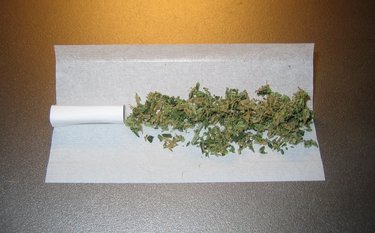Voorheesville to reexamine pot-shop proposal
VOORHEESVILLE — The public spoke and the Voorheesville Board of Trustees adjusted itself accordingly.
During a recent public hearing on the village’s proposed local law that would have Voorheesville opt out of both retail sales of marijuana and on-site consumption, the board heard very little in the way of agreement for its proposal.
Meanwhile, the town in which Voorheesville is located, New Scotland, has decided not to put an opt-out law up for a vote, meaning come Dec. 31, retail sales and on-site consumption of marijuana will be allowed in town.
The state’s Marijuana Regulation and Taxation Act of 2021 was signed into law in March. It made recreational marijuana use legal for people 21 and older in New York State, while its sale will be permitted once rules are established. But, even in the absence of state regulation on the matter, municipalities were still given only until Dec. 31 to opt out of allowing retail dispensaries or licenses for on-site consumption.
Local public hearings have been generally quiet affairs with few people speaking — and fewer speaking against the proposals. Voorheesville’s Nov. 4 public hearing largely followed that trend, as five residents spoke.
Just one dissented, asking that the village opt out of allowing pot shops while the remaining four made some version of the same argument: The village could be losing revenue, and what’s the harm?
The village has to opt out before Dec. 31 or “we can never opt out of this law,” Mayor Rick Straut said on Nov. 23, “That’s the way it is; that’s the way this works.” There is a bill currently presented by Republicans in both the state Senate and Assembly that would extend the opt-out date until Dec. 31, 2022.
Straut noted the Cannabis Control Board, which oversees the industry, had just started its work, and said his concern was that rules and regulations governing retail sales and on-site consumption had yet to be put in place.
While stating he wasn’t speaking for everyone on the board, Straut said he thought some of the concern was that “we don’t know the rules that go along with this,” for example, “if the rules establish something we don’t like or that we think would be detrimental to the village and we don’t opt out before the end of the year, we’re out of luck.”
“If we were to opt out and remain opted out then we are not able to share in the tax revenue that would be generated,” Straut said.
A number of layers of taxes are proposed with legalization, Straut said. Forty percent of the state tax is allocated for education; another 40 percent goes to communities impacted by the War on Drugs, in the form of grants to not-for-profit and community-based organizations; and 20 percent is for drug treatment and education.
“Then there’s a local excise tax that would come back to the county and the municipalities that do not opt out,” Straut said. “It’s unclear to me how that money, if we chose not to opt out, will be distributed. Whether it’s on sales that actually would occur in the village or whether we just share in any of the sales that occur within the county.”
He continued, “From what I’ve been able to read, I haven’t been clear on how that gets distributed.”
According to the state, the 4-percent tax that goes to the locality where the dispensary is located is apportioned based on sales — 1 percent is retained by the county and 3 percent goes to, or gets divvied up by, the municipality or municipalities with dispensaries. New York State additionally tacks on its own 9 percent.
Residents who spoke wondered what the loss of revenue would be to the village.
In fiscal year 2022, the state comptroller expects $20 million in statewide marijuana consumption taxes. Over the next three fiscal years, expected statewide marijuna tax revenues are expected to climb to $115 million, $158 million, and $245 million, respectively.
During the first six months of 2020, retail dispensaries averaged daily sales of about $8,600, according to data compiled by three companies operating in different parts of the cannabis industry: wholesale, retail, and employment.
So, hypothetically, if there were a single retail dispensary in Albany County and it was located in Voorheesville and it averaged daily sales of about $8,600, or about $3.14 million annually, the village would receive about $94,000 in tax revenue.
Albany County’s budget has yet to add a line item for retail marijuana revenue but it expects medical marijuana aid from the state to increase dramatically in 2022 compared this year, from $170,000 to $950,000.
The county’s 2020 medical marijuana aid from the state was about $583,000, which was about four times the state aid the county received in 2019. New York State took in $9 million in medical cannabis excise taxes in fiscal year 2021, and expects to receive $8 million in fiscal year 2022.
After further discussion, the board decided at its Dec. 21 meeting, it will decide among two local laws: The original proposal that would have Voorheesville opt out of both retail sales of marijuana as well as on-site consumption, and an alternate version of the law that would allow for retail sales but not on-site consumption.
New Scotland
New Scotland is unlike other local municipalities in deciding to allow both retail sales and on-site consumption of marijuana in town.
“That was kind of a general board decision on it,” Supervisor Douglas LaGrange said of not voting to opt out. The board didn’t want to exclude the town from revenue or any other opportunities, he said.
It’s a legal product, LaGrange said, “This is not something that people might consider an immoral situation ... I mean, how is a pot shop any different from a bar?” And, as for the problems that would come with a pot shop, LaGrange said, there would be “no more problems than we see with the local bar.”
To some degree, the town’s zoning takes care of the issue, LaGrange said.
Retail dispensaries would be allowed in the town’s commercial zones, largely the area around the intersection of routes 85 and 85A. There are also over a dozen commercially-zoned parcels near the intersection of routes 85 and 443, just outside Clarksville, near the town line with Berne.
The town’s zoning law also allows retail uses in its commercial hamlet districts, which Clarksville, Feura Bush, and New Salem each have. Retail is also an allowed use in New Scotland’s three mixed-economic development districts, which are made up of a number of parcels that dot the northeastern part of town.



